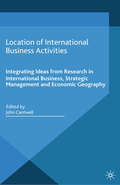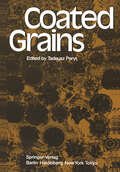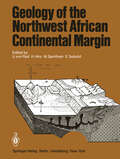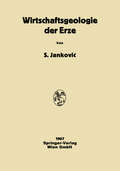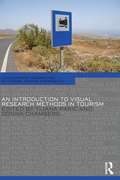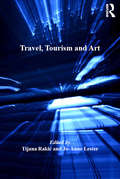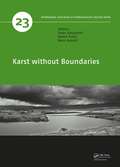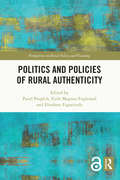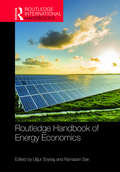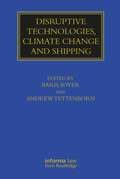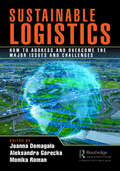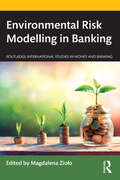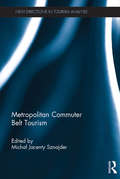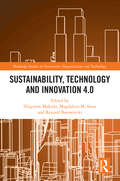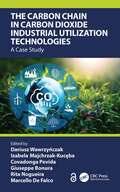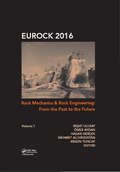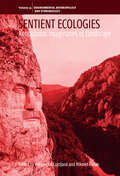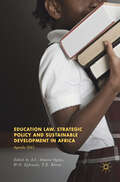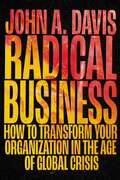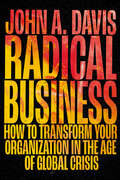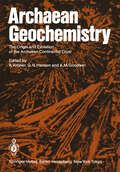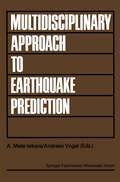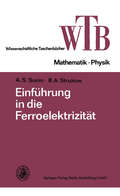- Table View
- List View
Location of International Business Activities: Integrating Ideas from Research in International Business, Strategic Management and Economic Geography (JIBS Special Collections)
by Academy of .In recent years an extensive range of new research has been revisiting the topic of the location of international business activities, from a variety of different perspectives and background interests. This work has been inspired in part by two apparently quite different but actually related contemporary trends: on the one hand, an emergence or revitalization of clusters of activities co-located in or around selected global city regions or fast growing metropolitan areas; and on the other hand, an increased global dispersion of activities conducted within the value chains managed or coordinated by many large multinational enterprises and their business partners. The former trend has given rise to discussions of how the elite of the cultural-cognitive economy of the 21st century (in Allen Scott's terminology) or the creative class (Richard Florida's term) are now being drawn or brought back to major urban centers; while the latter trend is associated with debates over outsourcing, and the economic and social consequences of shifts in the ownership and location of distinct nodes of value chains once production systems become more fragmented and the component parts of such systems become more geographically dispersed. An increased interest in the subject of international business location has been shown by scholars in Strategic Management, in Economic Geography, and in Regional Science, as well as in our own interdisciplinary field of International Business Studies. However, as is often the case in academic research communities, these bodies of scholarship have tended to develop at something of a distance from one another, each conversing internally more than they have with one another. Location of International Business Activities aims to promote a greater conversation between those interested in the topic of Location from various different backgrounds or starting points. The articles are taken from a special issue on the theme of the Multinational in Geographic Space which was published by The Journal of International Business Studies in 2013.
Coated Grains
by DrCoated grains have always attracted attention, at first of naturalists, and later of geologists, and the interest in these peculiar bodies was re lated both to their intriguing form and their significance in facies inter pretation and sedimentology and to their relevance to accumulations of hydrocarbons and other mineral deposits. This resulted in numerous publications on this subject, and the intention of this volume is to sum marize the present state of knowledge on coated grains. The idea of the book was to unite some general papers with papers reporting case studies of both recent and ancient coated grains. The organization of the book follows this intention. The papers presented in this volume have been invited by the editor; the theme of the book merits a few words of personal history. The development of studies of coated grains during the last two decades has not only resulted in a great increase in knowledge of recent and ancient environments of coated grain formation, but also numerous important and controversial questions of classification, environmental significance, mineralogical composition etc. of ancient coated grains have arisen. To answer these questions, in 1978 I started the study of many ancient and recent occurrences of coated grains at the Institut fUr Geologie, Ruhr-UniversiUH Bochum, following the invitation of Hans Fiichtbauer and sponsored by the Alexander von Humboldt-Stiftung.
An Introduction to Visual Research Methods in Tourism (Contemporary Geographies of Leisure, Tourism and Mobility)
by Tijana Raki 263 Donna ChambersAn Introduction to Visual Research Methods in Tourism is the first book to present, discuss and promote the use of a range of visual methods in tourism studies. It introduces methods ranging from the collection of secondary visual materials for the purposes of analysis (such as postcards, tourism brochures, and websites) and the creation of visuals in the context of primary research (such as photography, video and drawings), to the production of data through photo-elicitation techniques. The book promotes thoroughly underpinned interdisciplinary visual tourism research and includes an exploration of many key philosophical, methodological and inter-disciplinary approaches. Comprised of five parts: introduction; paradigms, academic disciplines and theory; methods; analysis and representation; and conclusion. This volume informs and inspires its readers through a reliance on theory, examples from tourism studies conducted in various geographical locations and through key pedagogical features such as annotated further readings, practical tips boxes and concise chapter summaries. This book will be of interest to experienced visual tourism researchers, scholars wishing to incorporate visual methods in their studies of tourism for the very first time, as well as students on undergraduate, postgraduate or doctoral programmes who are contemplating the incorporation of visual methods in their studies of tourism.
Travel, Tourism and Art (Current Developments in the Geographies of Leisure and Tourism)
by Tijana Raki 263 Jo-Anne LesterArt, in its many forms, has long played an important role in people’s imagination, experience and remembrance of places, cultures and travels as well as in their motivation to travel. Travel and tourism, on the other hand, have also inspired numerous artists and featured in many artworks. The fascinating relationships between travel, tourism and art encompass a wide range of phenomena from historical ’Grand Tours’ during which a number of travellers experienced or produced artwork, to present-day travel inspired by art, artworks produced by contemporary travellers or artworks produced by locals for tourist consumption. Focusing on the representations of ’touristic’ places, locals, travellers and tourists in artworks; the role of travel and tourism in inspiring artists; as well as the role of art and artwork in imagining, experiencing and remembering places and motivating travel and tourism; this edited volume provides a space for an exploration of both historical and contemporary relationships between travel, tourism and art. Bringing together scholars from a wide range of disciplines and fields of study including geography, anthropology, history, philosophy, and urban, cultural, tourism, art and leisure studies, this volume discusses a range of case studies across different art forms and locales.
Karst without Boundaries (Iah - Selected Papers On Hydrogeology Ser.)
by Zoran Stevanovi 263 Neven Kresi 263 Neno Kukuri 263Karstified rocks of different lithology cover more than 10% of the continental surface of our planet. It is known that some 20% or even a few percent more of the global population largely depends on karstic groundwater but in many karst areas all over the world there are limited natural resources including absence of drinking waters. The problems o
Ecofeminism on the Edge: Theory and Practice (Women, Economy and Labour Relations)
by Goran 272 Ur 273 Evi 263 Suzana Marjani 263Ecofeminism is defined as a unique academic discipline, theoretical framework, and political and philosophical movement centred around both environmental and feminist concerns. With a special focus on education and underrepresented geographical locations, Ecofeminism on the Edge: Theory and Practice is an inclusive collection of theories, discourses, art, identities, and practices related to this discipline. Expert contributors collaborate with junior scholars and early-stage researchers to demonstrate the compatibilities between different generations, academic backgrounds, political views, and gender perspectives for a holistic, globally conscious approach to ecofeminism and ecofeminist studies. Chapters focus on regions not yet represented in this discipline as well as emerging educational practices to provide a truly inclusive approach to the many creative solutions ecofeminism offers. Topics explored include promoting ecofeminisms plural as potential solutions for environmental and social crises, gender inequality, labour issues, and capitalism. An interdisciplinary approach to an interdisciplinary field, Ecofeminism on the Edge: Theory and Practice understands ecofeminism as a connective point between issues of gender and the environment, one with strong solutional potential for two distinct, yet often interconnected, fields.
Politics and Policies of Rural Authenticity (Perspectives on Rural Policy and Planning)
by Pavel Posp 283 Ch Eirik Magnus Fuglestad Elisabete FigueiredoThis book explores the notion of rurality and how it is used and produced in various contexts, including within populist politics which derives their legitimacy from the rural-urban divide. The gap between the ‘common people’ and the ‘elites’ is widening again as images of rurality are promoted as morally pure, unalienated and opposed to the cultural and economic globalization. This book examines how using certain images and projections of rurality produces ‘rural authenticity’, a concept propagated by various groups of people such as regional food producers, filmmakers, policymakers, and lobbyists. It seeks to answer questions such as: What is the rurality that these groups of people refer to? How is it produced? What are the purposes that it serves? Research in this book addresses these questions from the areas of both politics and policies of the ‘authentic rural’. The ‘politics’ refers to polarizations including politicians, social movements, and political events which accentuate the rural-urban divide and brings it back to the core of the societal conflict, while the ’policies’ focus on rural tourism, heritage industry, popular art and other areas where rurality is constantly produced and consumed. With international case studies from leading scholars in the field of rural studies, the book will appeal to geographers, sociologists, politicians, as well as those interested in the re-emergence of the rural-urban divide in politics and media.
Routledge Handbook of Energy Economics (Routledge International Handbooks)
by U 287 Ur Soyta 351 Ramazan Sar 305Energy consumption and production have major influences on the economy, environment, and society, but in return they are also influenced by how the economy is structured, how the social institutions work, and how the society deals with environmental degradation. The need for integrated assessment of the relationship between energy, economy, environment, and society is clear, and this handbook offers an in-depth review of all four pillars of the energy-economy-environment-society nexus. Bringing together contributions from all over the world, this handbook includes sections devoted to each of the four pillars. Moreover, as the financialization of commodity markets has made risk analysis more complicated and intriguing, the sections also cover energy commodity markets and their links to other financial and non-financial markets. In addition, econometric modeling and the forecasting of energy needs, as well as energy prices and volatilities, are also explored. Each part emphasizes the multidisciplinary nature of the energy economics field and from this perspective, chapters offer a review of models and methods used in the literature. The Routledge Handbook of Energy Economics will be of great interest to all those studying and researching in the area of energy economics. It offers guideline suggestions for policy makers as well as for future research.
Disruptive Technologies, Climate Change and Shipping (Maritime and Transport Law Library)
by Bar 305 351 Soyer Andrew TettenbornThis book analyses the impact of two vital and contemporary developments on shipping law and practice: disruptive technologies and climate change. It considers the impact of these new technologies, honing in on likely emerging issues and unresolved questions, especially about existing and potential private law liabilities and concentrates, from the point of view of English, EU and international law, on the legal implications of climate change and associated environmental risks in the shipping sector. Written by a contributor team drawn from the most experienced and knowledgeable academics and practitioners in shipping law, this treatment of these growing areas of practice will be of great use to lawyers and administrators across the world.
Sustainable Logistics: How to Address and Overcome the Major Issues and Challenges
by Joanna Domaga 322 A Aleksandra Górecka Monika RomanLogistics refers to the processes that start with resources and their acquisition, storage, and transportation to their destination. The concept is crucial in business -- particularly for the manufacturing sector -- to understand, manage, and control how resources are handled and progress through the whole supply chain. Now, there is a strong trend to focus on sustainability and eco-friendly solutions in logistics. Processes based on both technology and management need innovations and detailed implementation steps to achieve a satisfactory level of sustainability. This book explores how and where innovations can be implemented to provide a wide approach to sustainability in logistics. It addresses the main challenges affecting modern and sustainable logistics and supply chains and is organized according to six main themes: supply chain management; information intelligent hubs (e.g. warehouse and cities); sustainable transportation; technology for logistics; reverse logistics; and city logistics. The key results presented are based on both extensive types of research and business cases. The overarching advanced logistics and supply chain concepts at the heart of this book contribute to a sustainable intelligent logistics and transport system by making it more efficient, reliable, environmentally friendly, and competitive. Essentially, this book presents the most current research related to sustainability in logistics activities and addresses the theoretical background of sustainability and its significance for logistics, the challenges in supply chains and transportation, and possible solutions for more sustainable logistics systems.
Environmental Risk Modelling in Banking (Routledge International Studies in Money and Banking)
by Magdalena Zio 322 OEnvironmental risk directly affects the financial stability of banks since they bear the financial consequences of the loss of liquidity of the entities to which they lend and of the financial penalties imposed resulting from the failure to comply with regulations and for actions taken that are harmful to the natural environment. This book explores the impact of environmental risk on the banking sector and analyzes strategies to mitigate this risk with a special emphasis on the role of modelling. It argues that environmental risk modelling allows banks to estimate the patterns and consequences of environmental risk on their operations, and to take measures within the context of asset and liability management to minimize the likelihood of losses. An important role here is played by the environmental risk modelling methodology as well as the software and mathematical and econometric models used. It examines banks’ responses to macroprudential risk, particularly from the point of view of their adaptation strategies; the mechanisms of its spread; risk management and modelling; and sustainable business models. It introduces the basic concepts, definitions, and regulations concerning this type of risk, within the context of its influence on the banking industry. The book is primarily based on a quantitative and qualitative approach and proposes the delivery of a new methodology of environmental risk management and modelling in the banking sector. As such, it will appeal to researchers, scholars, and students of environmental economics, finance and banking, sociology, law, and political sciences.
Metropolitan Commuter Belt Tourism (New Directions in Tourism Analysis)
by Micha 322 Jacenty SznajderWith the current rise of metropolitan regions as a present location and driver of the development of rural tourism, agritourism, food tourism and nature tourism, there is a need to analyse the major economic, social, political and managerial aspects of these types of tourism which occur within the rural-urban fringe. This book establishes a current inventory and appropriate future selection of commuter belt tourism products for metropolitan areas. It also explains how public and private resources can be combined to achieve synergistic effects in tourism promotion and provides a structural analysis for the proper management of tourist organisations in metropolitan areas. Additionally, there is insight into how the development of metropolitan areas affects rural tourism and agritourism within broader social, economic and environmental relations. The issue of the growth of metropolitan areas, which is a complex and multifaceted challenge, is elaborated on with diverse examples in Poland and further afield. This is valuable reading for students, researchers and academics of tourism, as well as rural and urban studies, business management, farm management, and leisure studies.
Sustainability, Technology and Innovation 4.0 (Routledge Studies in Innovation, Organizations and Technology)
by Zbigniew Makie 322 A Magdalena M. Stuss Ryszard BorowieckiSustainability, Technology and Innovation 4.0 is a holistic perception and analysis of innovation at the level of public organisations, innovation in industry and innovation in HR. Its chapters collectively present a thesis that Innovation 4.0 signals a technological revolution that has the opportunity to prevent environmental degradation and, in particular, to stop climate warming, the effects of which may disrupt the process of sustainable development. Uniquely, this edited book offers a comprehensive and multi-faceted examination of Innovation 4.0, fulfilling methodical, empirical and utilitarian goals. The methodological objective is to present tools that allow the identification, analysis and assessment of the relationship between Innovation 4.0 and inspiration that will carry society towards a new economic and social order. Its empirical aim is to enable the analysis and evaluation of the role of public organisations, innovation in industry and innovation in HR in the process of building sustainable development of the global environment. The book’s utilitarian goal is a recommendation for global organisations of Innovation 4.0 as an instrument to stimulate an innovative economy. This is a high-level research book aimed at postgraduates, MBA students, researchers and academics from business colleges and universities, and may also provide a valuable strategic perspective for business executives.
The Carbon Chain in Carbon Dioxide Industrial Utilization Technologies: A Case Study
by Dariusz Wawrzy 324 Czak Izabela Majchrzak-Kucę Ba Covadonga Pevida Giuseppe Bonura Rita Nogueira Marcello De FalcoA shift towards implementation of renewable energy has disadvantages, such as power availability, storage capacity, and accompanying costs, and therefore the potential of clean fossil fuel technologies to ensure the stability of electricity generation needs to be reconsidered until these challenges will be overcome. These clean technologies can help prevent the greenhouse effect and, at the same time, guarantee energy security, as coal is a widespread, price-stable raw material that is available in large quantities. This book focuses on the carbon chain, starting from the formation of CO2, through its capture, possible cleaning, to the production of useful products such as dimethylether, methanol, and carbonated cement prefabricates. The comprehensive case study presents the research results of an international team established within the "CCS-CCU technology for carbon footprint reduction using bio-adsorbents" (BIOCO2) project.
Rock Mechanics and Rock Engineering: From the Past to the Future
by Re 351 At UlusayRock Mechanics and Rock Engineering: From the Past to the Future contains the contributions presented at EUROCK2016, the 2016 International Symposium of the International Society for Rock Mechanics (ISRM 2016, Ürgüp, Cappadocia Region, Turkey, 29-31 August 2016). The contributions cover almost all aspects of rock mechanics and rock engineering from theories to engineering practices, emphasizing the future direction of rock engineering technologies. The 204 accepted papers and eight keynote papers, are grouped into several main sections:- Fundamental rock mechanics- Rock properties and experimental rock mechanics- Analytical and numerical methods in rock engineering- Stability of slopes in civil and mining engineering- Design methodologies and analysis- Rock dynamics, rock mechanics and rock engineering at historical sites and monuments- Underground excavations in civil and mining engineering- Coupled processes in rock mass for underground storage and waste disposal- Rock mass characterization- Petroleum geomechanics- Carbon dioxide sequestration- Instrumentation-monitoring in rock engineering and back analysis- Risk management, and- the 2016 Rocha Medal Lecture and the 2016 Franklin Lecture Rock Mechanics and Rock Engineering: From the Past to the Future will be of interest to researchers and professionals involved in the various branches of rock mechanics and rock engineering. EUROCK 2016, organized by the Turkish National Society for Rock Mechanics, is a continuation of the successful series of ISRM symposia in Europe, which began in 1992 in Chester, UK.
Modeling Economic Growth in Contemporary Poland (Entrepreneurship and Global Economic Growth)
by El 380 Bieta Bukalska Tomasz Kijek Bruno S. SergiOver the past 15 years, Poland has been one of the fastest-growing countries in the European Union. Trying to explain the sources of Poland’s economic success and decouple it from simple stylized facts on economic convergence anchored in the neoclassical growth models, the authors show how the Polish economy rapidly moved away from the communist economic system, which had ended up in an economic collapse, and moved towards unprecedented growth in income and the quality of life. Analyzing the transition and contemporary challenges of the Polish economy – including resilience to COVID and the Ukraine war, issues relating to Polish economic growth’s institutional and policy framework, and the prospects of economic growth in Poland from the micro, mezzo, and macro perspectives – Modeling Economic Growth in Contemporary Poland is suitable for practitioners and academics interested in discovering the foundations for Polish growth, exploring whether this growth will likely last in the future. Entrepreneurship and Global Economic Growth presents modern examinations of economic growth at national, regional, and global levels. Each book in this series discusses different dimensions of the changing economic and industrial contexts and examines in detail their impact on the nature of growth and development.
Sentient Ecologies: Xenophobic Imaginaries of Landscape (Environmental Anthropology and Ethnobiology #31)
by Alexandra Co 539 Ofan 259 Hikmet KuranEmploying methodological perspectives from the fields of political geography, environmental studies, anthropology, and their cognate disciplines, this volume explores alternative logics of sentient landscapes as racist, xenophobic, and right-wing. While the field of sentient landscapes has gained critical attention, the literature rarely seems to question the intentionality of sentient landscapes, which are often romanticized as pure, good, and just, and perceived as protectors of those who are powerless, indigenous, and colonized. The book takes a new stance on sentient landscapes with the intention of dispelling the denial of “coevalness” represented by their scholarly romanticization.
Education Law, Strategic Policy and Sustainable Development in Africa: Agenda 2063
by A. C. Onuora-Oguno, W. O. Egbewole and T. E. KlevenThis book outlines the findings and suggestions of the Law and Society Association’s International Research Collaborations, which focused on the African Union’s Agenda 2063. This outlined the ideal Africa aspired to by the year 2063: ‘the Africa we want’. The authors examine socio-economic rights issues and their impact on developing a strong educational agenda that can drive Africa to realize Agenda 2063. As Africa’s development has remained slow in the face of many challenges, the need to embrace good governance, rule of law and human rights obligations are major tools to realize the continent’s potential. The project focuses in particular on the central place of education law and policy in achieving the goals of Agenda 2063.
Radical Business: How to Transform Your Organization in the Age of Global Crisis
by John A. DavisWe live in an age of global crises, from spiralling income inequality to the climate emergency. Businesses have been major contributors to the problems we face, but they are also uniquely well-placed to effect positive change. So what can businesses do to shift from being a makers of goods to a force for good? In Radical Business, John Davis argues the changes needed are surprisingly simple. The difficulty lies in the effort to change human behavior and to dismantle decades of investment that reinforces obsolete practices. He offers examples of companies that are already taking action and presents a simple framework to help C-suite leaders and executive teams develop their own blueprint for putting societal value at the heart of their business.; We can no longer ignore that established ways of doing business pose real existential threats to humankind. We cannot change what has occurred, but we can change how we do things from now on.
Radical Business: How to Transform Your Organization in the Age of Global Crisis
by John A. DavisWe live in an age of global crises, from spiralling income inequality to the climate emergency. Businesses have been major contributors to the problems we face, but they are also uniquely well-placed to effect positive change. So what can businesses do to shift from being a makers of goods to a force for good? In Radical Business, John Davis argues the changes needed are surprisingly simple. The difficulty lies in the effort to change human behavior and to dismantle decades of investment that reinforces obsolete practices. He offers examples of companies that are already taking action and presents a simple framework to help C-suite leaders and executive teams develop their own blueprint for putting societal value at the heart of their business.; We can no longer ignore that established ways of doing business pose real existential threats to humankind. We cannot change what has occurred, but we can change how we do things from now on.
Archaean Geochemistry: The Origin and Evolution of the Archaean Continental Crust
by A. Kröner, G. N. Hanson and A. M. GoodwinArchaean Geochemistry 1972 - 1984 The realisation that the continental crust contains well-preserved relics which date as far back as 4/5 of the Earth's age has given a great impetus to the study of early Precambrian terrains. As late as the mid-sixties the Archaean still constituted the 'terra-in cognita' of earth science. High metamorphic grades, poor out crop, and not least a widely assumed obliteration of early crustal records by convective recycling and thermal reworking had com bined to discourage research in this field. Many excellent local studies existed, notably around gold mining centres, but remained unrelated to a broader regional and theoretical understanding. This situation has changed as the consequence of two inter-related factors: (1) advances in isotopic methods and their application to Precambrian rocks, and (2) the recognition that some of the oldest terrains have retained a wealth of primary igneous and sedi mentary textures and even geochemical characteristics.
